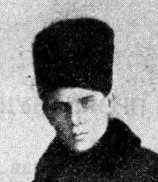Vasilisk Gnedov facts for kids
Vasily Ivanovich Gnedov (Russian: Васи́лий Ива́нович Гне́дов), also known by his pen name Vasilisk Gnedov (Russian: Васили́ск Гне́дов), was a very experimental poet in Russian Futurism. He was born on March 3, 1890, and passed away on November 20, 1978. Gnedov was known for trying new and unusual ways of writing poetry.
Contents
What Was Russian Futurism?
Russian Futurism was an art and poetry movement that started in Russia in the early 1900s. Artists and poets in this movement wanted to break away from old traditions. They wanted to create new forms of art that were modern and exciting. They often used bold language and unusual ideas. Gnedov was a part of this exciting time in Russian art.
His Most Famous Work: The Poem of the End
Gnedov is best known for his poem called Poem of the End. This poem was very unique. It was just its title on a blank page! When Gnedov performed it, he would use a silent gesture instead of speaking.
This poem was part of a collection called Death to Art (published in 1913). This collection had fifteen very short poems. Each poem got smaller and smaller. They went from one line, to one word, then one letter, and finally, Poem of the End was just a title on an empty page.
Why Was Poem of the End Important?
Many people compare Poem of the End to other famous artworks that were also very simple. For example, it's like Kazimir Malevich's painting Black Square (1915), which was just a black square on a white canvas. It's also similar to John Cage’s silent music piece 4'33" (1952). These works are all examples of Minimalism, which is an art style that uses very few elements.
Gnedov's Unique Poetic Style
Gnedov was part of a group called the Ego-Futurists. However, his poetry was more like the Hylaea or Cubo-Futurist group. Famous poets like Velimir Khlebnikov, Vladimir Mayakovsky, and Aleksei Kruchenykh were in that group.
Gnedov's other poems were known for their experimental language. He sometimes made up new words, similar to a style called zaum. He also used everyday language, words from different dialects, and even Ukrainian words. His poems often had a strong and bold voice. In 1913 and 1914, news reports often talked about Gnedov causing a stir. But he said his goal was "to invert and renew literature, to show new paths." He wanted to change literature and show new ways of writing.
Challenges and Later Life
Gnedov faced many difficulties in his life. He became ill and served in the military during World War I. He also experienced shell shock from fighting in the Revolution. Later, in the 1930s, he faced political repression, which meant his writing was stopped. These events made it very hard for him to continue writing.
After being released from Soviet camps in 1956, Gnedov started writing again. However, his new works were not published before he passed away in 1978. Today, some modern avant-garde poets, like Serge Segay and Rea Nikonova, see him as an important figure. They believe he helped shape Russian Modernism and opened new doors for poetry.


